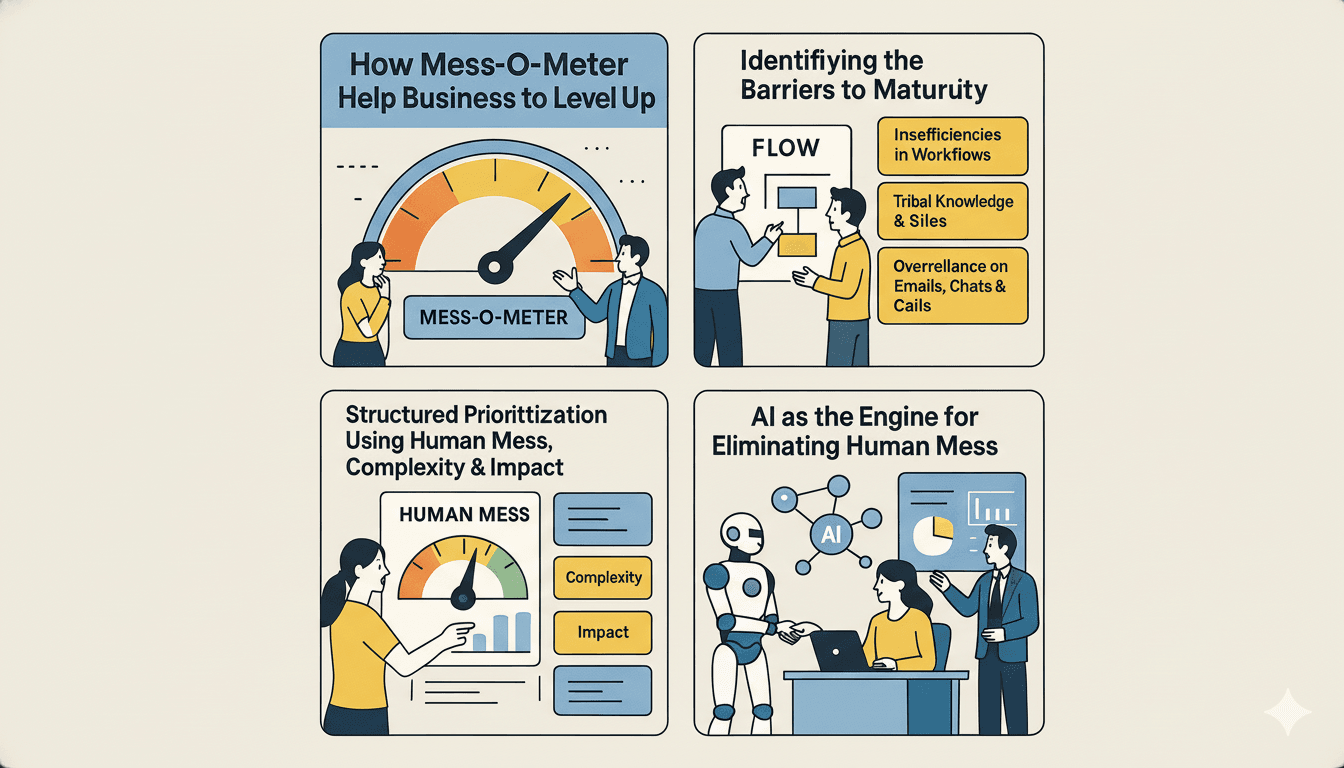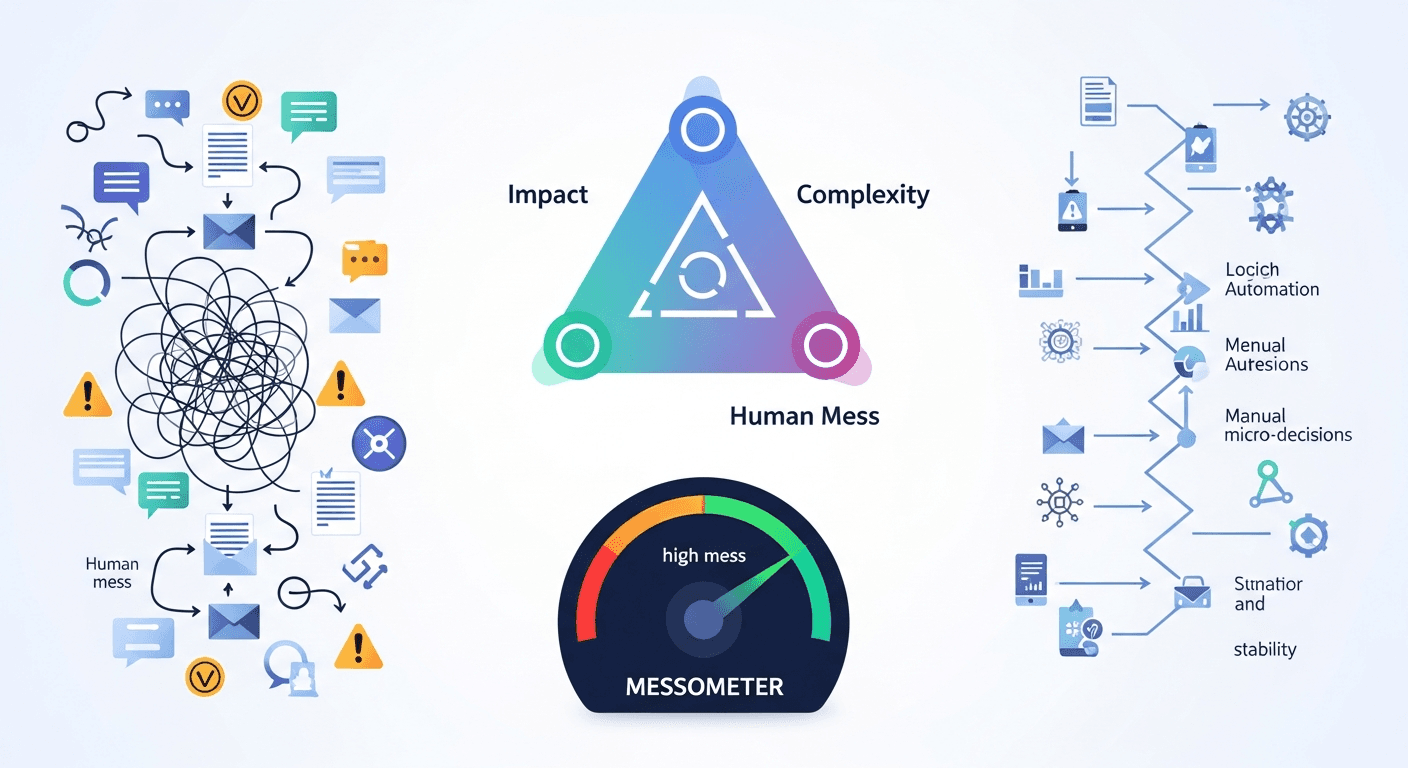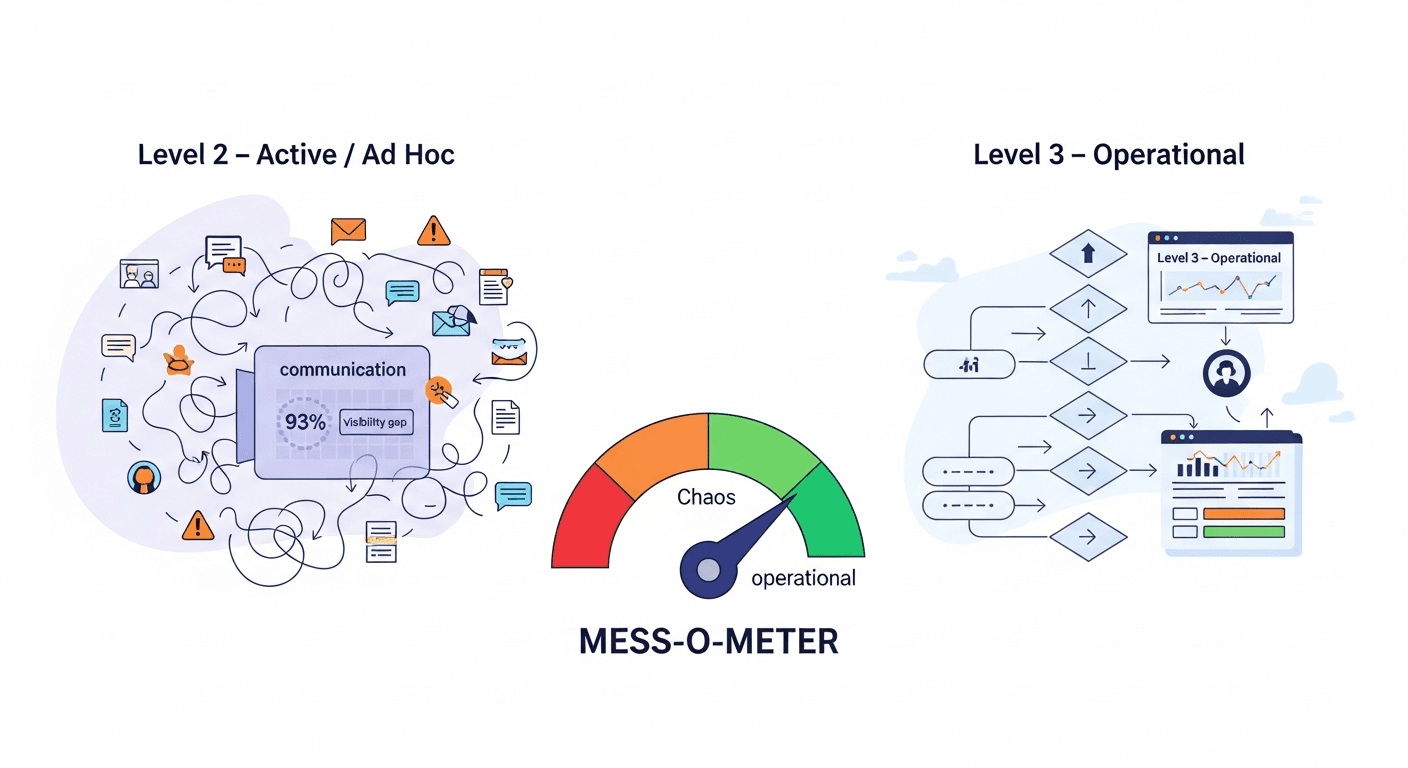Friday, 14 Nov 2025
|How Mess-O-Meter Helps Businesses Level Up with AI

How Mess-O-Meter Help Business to Level Up and Where AI Comes in All This?
Every business wants to “level up,” become more efficient, and operate with less chaos.
But the problem is simple: you can’t fix what you can’t see.
That’s why the Mess-O-Meter exists.
It shines a bright light on the hidden operational chaos—called Human Mess—that prevents businesses from reaching higher maturity levels. Once the mess is visible and measurable, AI steps in as the engine that removes the chaos, helping the business scale with speed, consistency, and intelligence.
In this article, we’ll walk through exactly how the Mess-O-Meter works, how it helps businesses level up, and how AI becomes the key to eliminating inefficiency.
Understanding the Mess-O-Meter as a Business Diagnostic Tool
The Mess-O-Meter is not a single number or a simple chart—it’s a strategic diagnostic system designed to detect:
- Workflow breakdowns
- Communication overload
- Human-dependent processes
- Manual micro-decisions
- Siloed operations
- Hidden delays
- Tribal knowledge bottlenecks
It answers the most important question in modern operations:
👉 “Where exactly is the mess that stops us from improving?”
What “Human Mess” Really Means
Human Mess is the operational chaos created by:
- People improvising because processes are unclear
- Relying on chats, emails, and calls instead of systems
- Needing humans to make hundreds of tiny decisions daily
- Knowledge living inside people’s heads
- Lack of structure, standards, and visibility
This mess is not the fault of employees—it is the result of:
- Bad workflows
- Poor documentation
- Outdated tools
- Overgrown processes
- Frequent exceptions
- Legacy thinking
The Mess-O-Meter quantifies this so leaders can see it clearly.
Why Visibility Is the First Step Toward Maturity
Most organizations operate in a Communication Black Box.
They have dashboards for metrics.
They have SOPs for tasks.
But they have no visibility into:
- Why delays happen
- Who is making micro-decisions
- Where manual work slows everything down
- Why exceptions keep occurring
- How much time employees waste on communication
This is why businesses get stuck in lower maturity stages.
The Mess-O-Meter breaks open the black box.
How the Mess-O-Meter Helps Businesses Level Up
The Mess-O-Meter is used inside a Framework for Structured Decisioning and Prioritization.
This helps businesses climb the maturity ladder strategically instead of chaotically.
Here’s how it works step-by-step.
Step 1: Identifying the Barriers to Maturity (The Human Mess)
The Mess-O-Meter identifies the hidden factors keeping the business stuck in low maturity levels such as “Basic,” “Opportunistic,” or “Executional View.”
Workflow Inefficiencies
These include:
- Manual steps
- Repeated handoffs
- Rework loops
- Exception handling
Example:
A warehouse team rechecks the same inventory data three times because systems don’t sync reliably.
Tribal Knowledge & Silos
Teams rely on individuals who “know how things are done.”
This kills scalability.
Example:
Only one person knows how to manage escalations in shipping.
Overreliance on Emails, Chats & Calls
Endless conversations = endless delays.
Example:
Coordinating shipment exceptions requires 15 Slack messages and 3 approvals.
Manual Checks & Micro-Decisions
Employees make dozens of tiny decisions daily that should be automated.
Example:
A support agent manually tags every ticket because the system cannot detect categories.
Step 2: Structured Prioritization Using Human Mess + Impact + Complexity
Once mess is measured, the organization can prioritize intelligently using three inputs:
Human Mess – how chaotic the workflow is
Impact – how valuable it would be to fix
Complexity – how difficult it would be to improve
This method produces a clear prioritization map.
Instead of guessing, businesses can now say:
👉 “This process has high mess, high impact, and low complexity—fix it first.”
This directs investment to high-value opportunities.
Step 3: Directing Investment and Moving Up the Maturity Curve
By quantifying the mess, the business can finally:
- Improve People + Process + Technology
- Strengthen leadership and governance
- Build scalable workflows
- Reduce dependency on individuals
- Move from Level 2/3 Execution to Level 4 Systemic
The strategic goal becomes:
👉 From Human Mess → Greater Human Potential
This is exactly where AI enters.
Where AI Comes Into This Process
Once the Mess-O-Meter identifies the chaos, AI is the tool that removes it.
AI isn’t added randomly.
It is deployed precisely where the Mess-O-Meter has revealed:
- Bottlenecks
- Manual decisions
- Communication friction
- High human dependency
- Slow workflows
AI becomes the muscle behind the strategy.
AI as the Engine for Eliminating Human Mess
AI transforms messy workflows into clean, automated, scalable systems.
Reimagining Workflows with Agentic AI
AI Agents can:
- Read emails
- Automate decisions
- Classify tickets
- Generate documents
- Handle exceptions
- Assign tasks
- Communicate with systems
Instead of humans doing 100 small tasks, AI agents handle them automatically.
Automating Micro-Decisions
Micro-decisions include:
- “Which carrier should we pick?”
- “Does this order need re-routing?”
- “Is this message urgent?”
- “Which warehouse has nearest stock?”
AI can make these decisions instantly.
Streamlining Communication-Heavy Processes
AI reduces:
- Chat threads
- Manual follow-ups
- Email loops
- Phone approvals
AI becomes the “always on” operator that removes the need for human coordination.
Role of AI Agents and Orchestration Layers
To scale automation, businesses use:
- Multiple AI Agents
- An orchestration layer
- Workflow engines
- Decision models
- Knowledge graphs
This turns chaotic processes into automated, intelligent workflows.
AI Governance: The AI Council
As AI expands, an AI Council ensures:
- Alignment
- Compliance
- Standardization
- Risk management
- Scaling best practices
Governance is what shifts a company into higher maturity levels.
How Mess-O-Meter + AI Accelerate Maturity Levels
Move from Level 2–3 Execution → Level 4 Systemic
The Mess-O-Meter reveals the blockers.
AI removes the blockers.
Governance scales the improvements.
This combination propels businesses to Level 4 maturity—where processes become:
- Predictable
- Automated
- Standardized
- Measurable
- Efficient
Measurable Outcomes
Businesses see improvement such as:
- Higher warehouse throughput
- Lower cost per shipment
- Fewer reships and claims
- Faster cycle times
- Happier customers
- Lower operational costs
- More confident decision-making
This is what “leveling up” looks like.
Real-World Examples of Mess-O-Meter + AI in Action
1. Logistics & Warehouse Operations
Mess:
Scheduling pickups requires 30+ messages.
AI Fix:
AI agent auto-schedules pickups and updates systems.
Outcome:
Faster workflows + fewer errors.
2. Customer Support
Mess:
Agents manually route every ticket.
AI Fix:
AI auto-classifies and routes messages.
Outcome:
Faster response times + reduced agent workload.
3. Retail Inventory
Mess:
Inventory exceptions need human approval.
AI Fix:
AI resolves common exceptions automatically.
Outcome:
Higher throughput + less human firefighting.
See your Mess-O-Meter in minutes.
FAQs
1. What is the Mess-O-Meter?
A diagnostic tool that measures the hidden chaos inside workflows.
2. Why do businesses need it?
Because most companies cannot see where the real inefficiencies are.
3. How does the Mess-O-Meter help with AI?
It tells you exactly where AI should be deployed for maximum impact.
4. Does AI replace people?
No—it removes low-value work so people can focus on high-value work.
5. Can the Mess-O-Meter be used in any industry?
Yes—logistics, retail, finance, support, healthcare, SaaS, and more.
6. What happens after the mess is removed?
The business becomes more scalable, predictable, efficient, and mature.
Conclusion
The Mess-O-Meter helps businesses level up by making invisible chaos visible.
Once the mess is measured, AI becomes the force that removes it—automating manual decisions, streamlining communication, and upgrading processes into intelligent workflows.
This combination—Mess-O-Meter + AI—is how modern businesses accelerate into higher maturity levels and unlock their full potential.
All blog posts
View All →
Tuesday, 18 Nov 2025
AI Prioritization with the Mess-O-Meter Framework
Triangulate impact, complexity, and human mess with the messometer to prioritize AI projects scientifically and reduce failure risk.

Monday, 17 Nov 2025
Escape Level 2 AI Maturity with the Mess-O-Meter
Use the messometer to measure manual micro-decisions and chaotic workflows so you can move from ad hoc AI experiments to operational, scalable AI.

Saturday, 15 Nov 2025
The 93% Visibility Gap: Why the Mess-O-Meter Is Your Powerful First Step in the AI Maturity Journey
Discover how the messometer exposes the hidden “communication black box” in your workflows. Learn why diagnosing this 93% visibility gap is essential before any AI implementation to avoid failure.